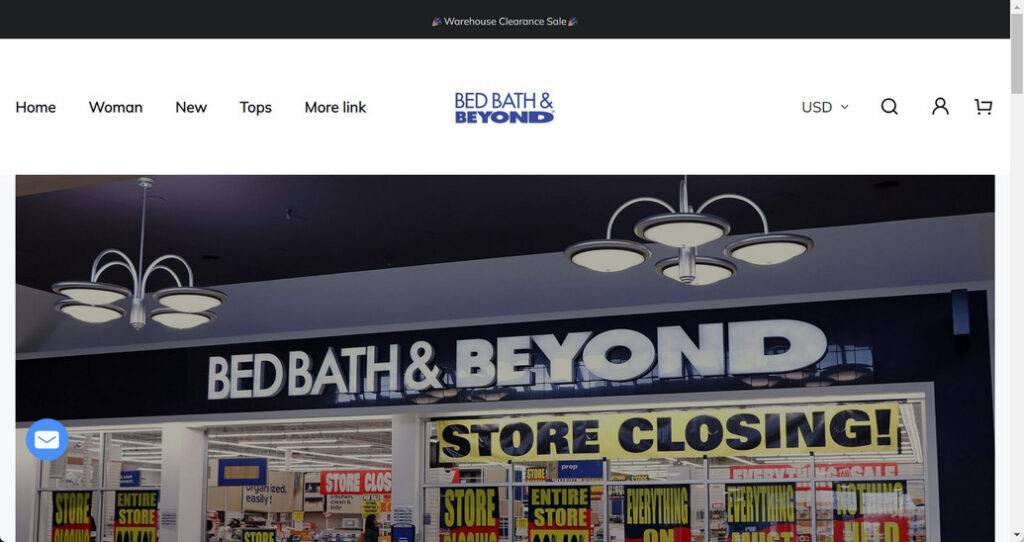Savvy online shoppers are always on the lookout for the best deals. However, criminals are also well aware of this bargain hunting behavior and have crafted sophisticated “Warehouse Clearance Sale” scams impersonating many top retailers. This article will expose how these complex fake shopping websites operate, tips for identifying them, and how to protect yourself if you have entered information on one. Avoid getting duped by only shopping on legitimate sites that have been fully verified.

This Article Contains:
What Are the Warehouse Clearance Sale Scam Sites?
The Warehouse Clearance Sale scam websites refer to a series of fraudulent sites that falsely pose as authorized clearance sales for major retailers like Bed Bath & Beyond, buybuy BABY, Amazon, Kohl’s, Macy’s, and others. These elaborate fake domains use the real brands’ logos, images, and website designs in order to trick customers.
They create lookalike URLs with the retailer name and phrases like “warehouse clearance” or “outlet clearance” to deceive people into thinking steep discounts are being offered due to inventory liquidations. However, the sites have no connection to the actual companies. They simply steal personal and financial data entered on the site.
Some common red flags of these scam websites include:
- URL contains “warehouse clearance” or similar wording
- Abnormally low prices advertised for expensive name brand merchandise
- Lack of real contact information for the company like phone, address, email
- Poor grammar/spelling errors throughout the site
- Credit card logos look blurry or altered
How the Warehouse Clearance Sale Scams Operate
The criminals running these fake shopping websites go to great lengths to make them look legitimate. Here are some of the deceptive strategies they use:
- Purchase online ads promoting the scam site as an authorized warehouse clearance event for a major brand.
- Mimic the real company’s website design, images, logos, and overall appearance to look authentic at quick glance.
- Offer absurdly huge discounts on expensive products like appliances and electronics that seem too good to be true.
- Make adding items to cart and checking out appear to work normally until error messages pop up right before confirming purchase.
- Bury tricky terms and conditions with hidden fees, subscriptions, and fine print allowing them to overcharge cards.
- Quietly enroll users in recurring monthly memberships without consent when credit card details are entered.
- Never fulfill any of the orders, since the sites have no actual warehouse or inventory.
- Sell off any collected personal information like names, addresses, and credit card numbers to other criminal enterprises.
- Provide fake customer service phone numbers and contact info that simply lead to disconnected lines, anonymous voicemail inboxes, or answering machines.
- Make it extremely difficult to cancel monthly subscription fees if unwittingly signed up.
The well-planned nature of these schemes allows the scam websites to dupe online shoppers who think they are on a legitimate retailer’s clearance page. But customers end up receiving no products while having their data compromised.
What to Do if You Encountered a Fake Warehouse Clearance Site
If you suspect you may have placed an order or provided personal information on one of these fraudulent Warehouse Clearance Sale websites, take these steps immediately:
- Call your credit card company to report any unauthorized charges and have new cards issued with different card numbers.
- Carefully check bank and credit card statements over the next few months and dispute any recurring mystery fees or subscriptions.
- Monitor your credit reports for any signs of new accounts fraudulently opened using your identity. Place credit freezes if needed.
- Change passwords on all online accounts, especially any that may have reused the same password as the one entered on the scam website.
- Contact the real retailer being impersonated to notify them of the scam website misusing their brand without permission.
- Report the fake website to the FTC, IC3, BBB, and other consumer protection agencies to aid investigation efforts.
- Leave online reviews warning others about the specific scam website if you come across it while browsing.
How to Identify Authentic Websites
When searching for online deals, be sure to verify site legitimacy by:
- Cross-checking the URL against the real retailer’s official website address.
- Comparing listed prices against the true website since fakes advertise unrealistic discounts.
- Looking for proper contact information like a working customer service phone number, physical addresses, and email.
- Ensuring the site has the “https” URL protocol and padlock security icon.
- Watching for grammatical errors, typos, and other warning signs of amateur scam sites.
- Completing a domain name search to see if the site was very recently created.
- Checking for certificates of trust seals like Norton Verified, McAfee SECURE, and BBB.
Conclusion
In summary, consumers should be very wary of “too good to be true” warehouse clearance sales with deeply discounted pricing on name brand merchandise. Verify site details and cross-check deals against the retailer’s real website. Also confirm security features are in place before entering payment information. With proper scrutiny, shoppers can avoid the complex but fake Warehouse Clearance Sale scam websites that prey on bargain hunters. Carefully check sites to continue enjoying the benefits and convenience of online shopping securely.










